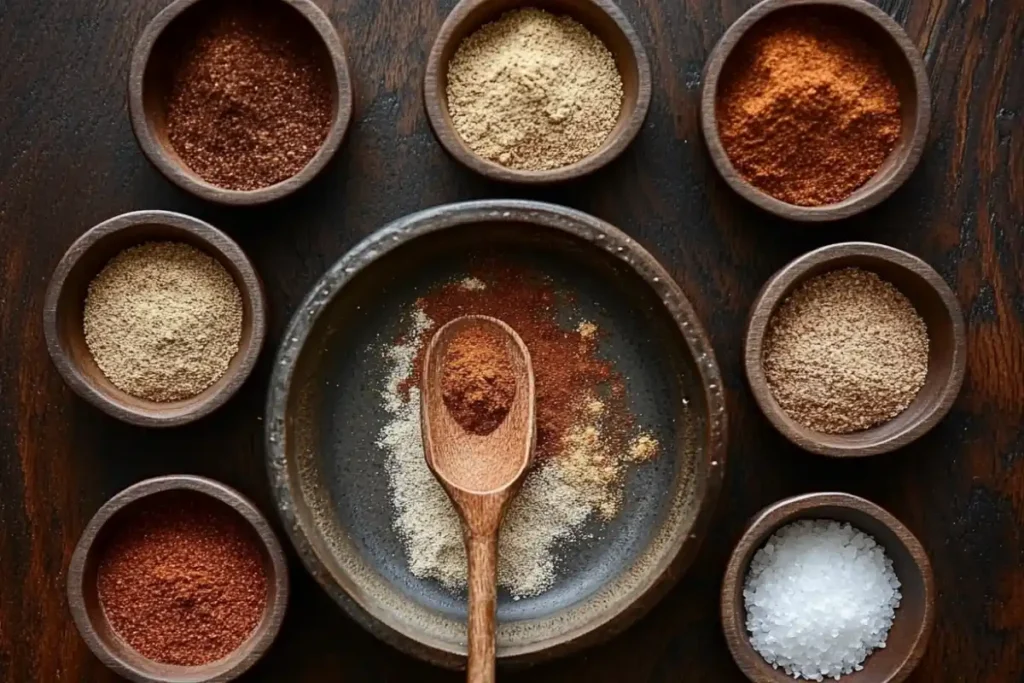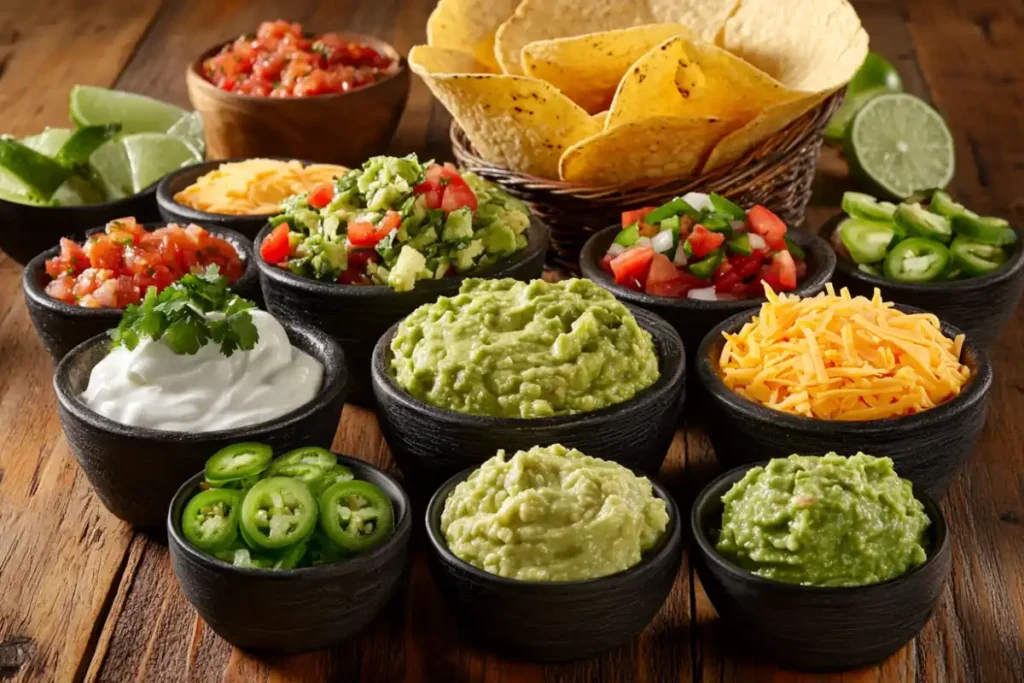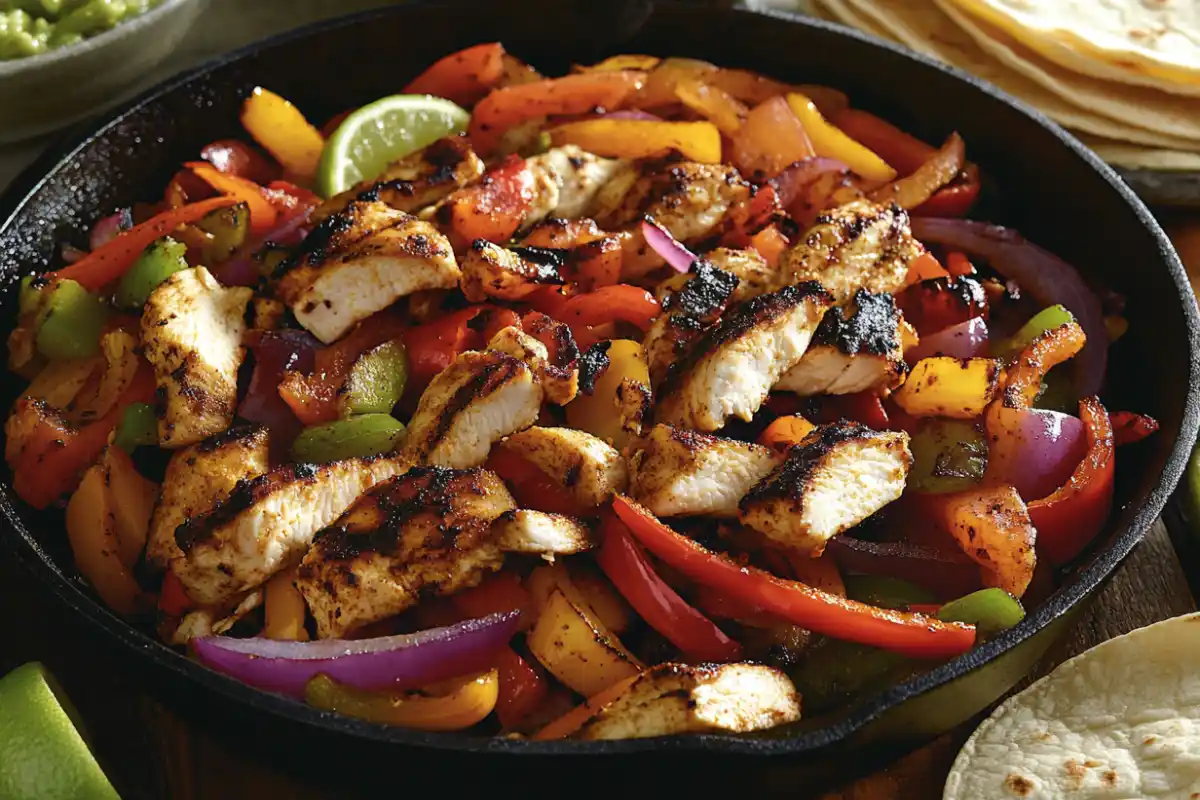Fajitas are a Tex-Mex favorite, known for their sizzling presentation, bold flavors, and versatility. But if you’re following a gluten-free diet, you might be wondering: How can I make fajitas gluten-free? The good news? It’s totally doable with the right ingredients and cooking methods!
In this guide, we’ll break down everything you need to know to make delicious, gluten-free fajitas at home. From choosing safe ingredients and making homemade seasoning to selecting the best tortillas and sides, we’ve got you covered. Whether you have celiac disease, gluten sensitivity, or simply want to eat cleaner, these tips will help you enjoy fajitas without any worry.
Let’s start with the basics!
Introduction to Gluten-Free Fajitas
Before diving into ingredients and cooking methods, let’s understand why traditional fajitas may contain gluten and what you need to watch out for.
What Are Fajitas?
Fajitas are a classic Tex-Mex dish, traditionally made with grilled meat (chicken, beef, or shrimp) and sautéed bell peppers and onions. They’re usually served on a sizzling hot plate alongside flour tortillas, guacamole, salsa, cheese, and sour cream. While fajitas themselves are naturally gluten-free, some ingredients sneak in gluten, making them unsafe for gluten-sensitive individuals.
Why Choose a Gluten-Free Version?
For those with celiac disease or gluten intolerance, consuming gluten can cause digestive issues, inflammation, and other health concerns. Even if you’re not gluten-sensitive, making fajitas gluten-free can be a healthier option since it eliminates processed ingredients that often contain hidden gluten.
Common Gluten Sources in Traditional Fajitas
Many fajita recipes contain gluten without you realizing it. Here’s where gluten might be hiding:
- Flour Tortillas – Most traditional fajitas come with wheat-based tortillas, which contain gluten.
- Pre-Packaged Seasonings – Many store-bought fajita seasonings contain wheat starch, maltodextrin, or artificial additives that have gluten.
- Soy Sauce or Marinades – Some marinades use soy sauce, which often contains wheat.
- Cross-Contamination in Restaurants – Even if a restaurant fajita dish seems gluten-free, it could be cooked on the same surface as gluten-containing foods.
Now that you know what to avoid, let’s move on to choosing the right gluten-free ingredients to make safe, delicious fajitas at home!
Choosing Gluten-Free Ingredients
Now that you know where gluten might be hiding in traditional fajitas, it’s time to choose the right gluten-free ingredients. From tortillas to seasonings, each element plays a crucial role in making fajitas delicious and safe.
Gluten-Free Protein Options
The good news? Most proteins are naturally gluten-free! Whether you prefer chicken, beef, shrimp, or tofu, all are safe as long as they’re not marinated in a gluten-containing sauce. Here are some tips:
- Use fresh, unprocessed meats instead of pre-seasoned or marinated versions, which often contain soy sauce or wheat-based fillers.
- Opt for grass-fed beef or organic chicken for a healthier, more flavorful dish.
- If using plant-based options like tofu or tempeh, check the packaging for any gluten-containing additives.
Safe Vegetables for Fajitas
Veggies are a big part of Tex-Mex cooking, and luckily, most are naturally gluten-free. Classic fajita veggies include:
- Bell peppers (red, yellow, green, and orange)
- Onions (red, white, or yellow)
- Mushrooms (great for added texture!)
- Zucchini or squash for a unique twist
Make sure they’re washed thoroughly to avoid cross-contamination, especially if you’re prepping on a surface that previously had gluten-containing foods.
Finding or Making Gluten-Free Tortillas
Traditional fajitas are served with flour tortillas, which are not gluten-free. But don’t worry—there are several alternatives:
- Corn tortillas – Always check the label! Some brands mix in wheat flour.
- Cassava flour tortillas – A soft, pliable option that closely mimics wheat tortillas.
- Lettuce wraps – A low-carb, fresh alternative.
- Homemade gluten-free tortillas – You can make your own using cassava, almond, or coconut flour for a completely safe option.
For an in-depth look at which tortillas work best for fajitas, check out this guide on Chef’s Tasty Recipes.
Gluten-Free Fajita Seasoning
One of the biggest gluten culprits in fajitas is pre-made seasoning. Many store-bought blends contain wheat starch, maltodextrin, or fillers. The best way to avoid gluten? Make your own seasoning!

Gluten in Store-Bought Seasonings
If you’re buying fajita seasoning, read the ingredient list carefully. Some hidden gluten sources include:
- Maltodextrin (often derived from wheat)
- Modified food starch
- Wheat flour (sometimes used as an anti-caking agent)
- Soy sauce powder (contains wheat)
To be safe, look for brands labeled gluten-free or make your own blend at home.
How to Make Homemade Gluten-Free Fajita Seasoning
Making your own fajita seasoning ensures a flavorful, gluten-free mix without unnecessary additives. Here’s a simple recipe:
Ingredients:
- 1 tbsp chili powder
- 1 tsp smoked paprika
- 1 tsp cumin
- ½ tsp garlic powder
- ½ tsp onion powder
- ½ tsp salt
- ¼ tsp black pepper
- ¼ tsp cayenne pepper (optional, for heat)
Instructions:
- Mix all ingredients in a bowl.
- Store in an airtight container for up to 6 months.
- Use 1-2 teaspoons per pound of protein or vegetables.
For more tips on seasoning and how to adjust flavors, check out this fajita seasoning guide.
Best Herbs and Spices for Gluten-Free Fajitas
Want to take your fajitas to the next level? Try adding:
- Fresh cilantro – A bright, citrusy finish.
- Oregano – Adds depth and a hint of sweetness.
- Lime zest – Boosts the freshness and pairs well with smoky flavors.
With the right gluten-free ingredients and seasonings, you’re well on your way to making amazing, restaurant-quality fajitas at home! Up next, we’ll explore the best cooking methods to bring out the boldest flavors.
Cooking Methods for Gluten-Free Fajitas
Cooking fajitas is all about sealing in flavor while keeping the ingredients fresh and vibrant. Whether you love a classic stovetop sizzle or prefer a hands-off oven-baked method, the right technique ensures your gluten-free fajitas turn out perfect every time.
Stovetop vs. Oven-Baked Fajitas
Both stovetop and oven-baked methods work well for making fajitas. However, each has its pros and cons:
- Stovetop cooking gives a fast, high-heat sear, creating the signature caramelization on meat and veggies. Use a cast-iron skillet or stainless steel pan for best results.
- Oven-baked fajitas require less hands-on work. Everything roasts evenly on a sheet pan, making this method great for meal prep or feeding a crowd.
For stovetop fajitas:
- Heat a tablespoon of oil over medium-high heat.
- Add the seasoned meat and cook until browned. Remove and set aside.
- Toss in bell peppers and onions, sautéing until slightly tender.
- Return the meat to the pan, mix well, and cook for another minute.
For oven-baked fajitas:
- Preheat the oven to 400°F (200°C).
- Toss sliced meat, peppers, and onions with seasoning and oil.
- Spread on a sheet pan and bake for 20-25 minutes, stirring halfway through.
Using a Grill for Gluten-Free Fajitas
Grilling fajitas adds a smoky depth to the meat and vegetables. To do it right:
- Use a grill pan or barbecue to cook thinly sliced meat over medium-high heat.
- Marinate for at least 30 minutes before grilling to keep the meat tender.
- Grill for 2-3 minutes per side, then let the meat rest before slicing.
One-Pan and Sheet-Pan Cooking Methods
Want an easy clean-up option? Try a one-pan fajita method:
- Cook everything in a large skillet or Dutch oven for a quick, fuss-free meal.
- Or, use a sheet pan to roast everything at once. This method is ideal for busy weeknights when you need a simple, gluten-free meal.
Now that you know how to cook them, let’s explore the best gluten-free sides and toppings to complete your fajita feast!
Gluten-Free Fajita Sides and Toppings
No fajita meal is complete without the right sides and toppings. But when going gluten-free, it’s essential to choose safe options that enhance flavor without adding unwanted gluten.

Safe Gluten-Free Side Dishes
Pair your fajitas with tasty, naturally gluten-free sides like:
- Mexican rice – Made with tomatoes, spices, and broth. Always check that store-bought versions don’t contain wheat-based thickeners.
- Cilantro lime rice – A fresh, zesty alternative that balances the spice in fajitas.
- Black beans or refried beans – Choose canned varieties labeled gluten-free to avoid hidden wheat ingredients.
- Grilled corn on the cob – A smoky, slightly sweet side that pairs perfectly with spicy fajitas.
- Guacamole or avocado slices – Adds a creamy, cooling contrast.
Choosing Gluten-Free Salsa, Guacamole, and Sour Cream
Most fresh salsas and guacamole are naturally gluten-free, but be cautious with:
- Store-bought dips – Some brands add starches or preservatives that contain gluten. Always check labels!
- Flavored sour creams – Stick to plain sour cream to avoid additives.
- Queso dip – While homemade queso is safe, some processed cheese sauces use flour as a thickener.
Alternative Toppings for Extra Flavor
Get creative with gluten-free toppings that add crunch, heat, or freshness:
- Pickled red onions – A tangy contrast to rich meats.
- Crumbled queso fresco – A mild, creamy cheese option.
- Fresh jalapeño slices – For those who love an extra kick!
- Sliced radishes – Adds a crisp, peppery bite.
Want to experiment with more Mexican-inspired dishes? Check out this guide on fajita toppings for more ideas!
Now that your gluten-free fajitas are complete, let’s move on to how to store and reheat them without losing flavor!
Storing and Reheating Gluten-Free Fajitas
Once you’ve made a delicious batch of gluten-free fajitas, you might wonder: How can I store and reheat them without losing flavor and texture? Whether you have leftovers or are meal-prepping for the week, here’s how to keep them fresh.
Best Practices for Refrigerating and Freezing
Fajitas store well in the fridge or freezer, but separating ingredients is key to avoiding soggy vegetables and dry meat.
- Refrigeration:
- Store cooked meat and veggies in an airtight container for up to 4 days.
- Keep gluten-free tortillas separate to prevent them from getting soggy.
- Store toppings like guacamole or sour cream in small, airtight containers.
- Freezing:
- Fajita meat freezes well for up to 3 months. Let it cool completely before sealing in a freezer-safe bag.
- Avoid freezing cooked vegetables, as they tend to lose texture when reheated. Instead, slice fresh veggies when you’re ready to eat.
How to Reheat Without Losing Flavor and Texture
Reheating fajitas the right way prevents dryness and keeps the flavors fresh.
- Stovetop (Best Method):
- Heat a skillet over medium heat, adding a splash of water or oil.
- Stir meat and veggies for 3-4 minutes until warmed through.
- Oven (For Larger Portions):
- Preheat to 350°F (175°C) and place fajitas on a baking sheet.
- Cover with foil and bake for 10-12 minutes.
- Microwave (Quickest Option):
- Place fajitas in a microwave-safe dish and cover with a damp paper towel.
- Heat in 30-second intervals, stirring in between, until warm.
Now that you know how to store and reheat fajitas properly, let’s answer some common gluten-free fajita questions!
Frequently Asked Questions
If you’re wondering, “How Can I Make Fajitas Gluten-Free?”, you’re not alone! Here are answers to some of the most frequently asked questions.
Can I Use Corn Tortillas for Gluten-Free Fajitas?
Yes! Corn tortillas are naturally gluten-free, but always check labels—some brands mix in wheat flour. If you want an alternative, try cassava or almond flour tortillas for a more flexible, soft texture.
What Store-Bought Fajita Seasonings Are Gluten-Free?
Some store-bought fajita seasoning mixes contain gluten-based fillers, so always read ingredient lists. Popular gluten-free brands include:
- McCormick Gluten-Free Fajita Seasoning
- Simply Organic Fajita Mix
- Old El Paso Gluten-Free Fajita Seasoning
Or, make your own seasoning using chili powder, cumin, garlic powder, and smoked paprika for a fresh, gluten-free blend!
How Can I Make Fajitas Without Any Grains?
For a grain-free fajita experience, swap tortillas for:
- Lettuce wraps – Crisp and refreshing.
- Bell pepper halves – Stuff fajita fillings into grilled peppers.
- Cauliflower rice – A great base instead of traditional rice.
Are Restaurant Fajitas Safe for Gluten-Free Diets?
Not always. Many restaurant fajitas contain gluten from marinades, seasonings, or tortillas. If eating out, ask:
- Do you use wheat in your seasoning or marinades?
- Are the fajitas cooked on a shared grill with gluten foods?
- Can you provide corn tortillas instead of flour ones?
To be extra safe, making homemade gluten-free fajitas ensures you control every ingredient!
Now that you have all the information, it’s time to enjoy flavorful, safe, and satisfying gluten-free fajitas at home!
Conclusion: Enjoying Delicious Gluten-Free Fajitas
Now that we’ve answered the question, “How Can I Make Fajitas Gluten-Free?”, you have everything you need to create safe, flavorful, and satisfying fajitas at home. By choosing gluten-free ingredients, making homemade fajita seasoning, and using the right cooking methods, you can enjoy this classic Tex-Mex dish without worry.
From corn tortillas and grain-free alternatives to stovetop, oven, and grill cooking methods, there are countless ways to customize your gluten-free fajitas to match your taste and dietary needs. Plus, with the right sides, toppings, and storage tips, you can enjoy leftovers just as fresh as the first bite.
If you’re dining out, always double-check with restaurants about hidden gluten in marinades, seasonings, and tortillas. But when making fajitas at home, you have complete control over what goes into your dish—ensuring a safe and delicious meal every time.
So grab your favorite protein, fresh veggies, and bold seasonings, and start cooking your gluten-free fajitas today!
